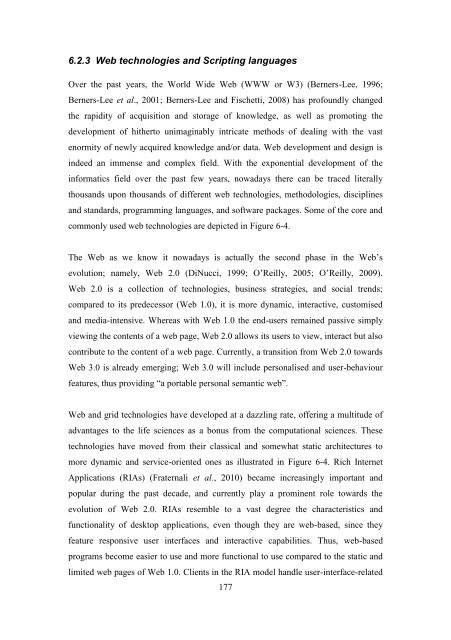CRANFIELD UNIVERSITY Eleni Anthippi Chatzimichali ...
CRANFIELD UNIVERSITY Eleni Anthippi Chatzimichali ...
CRANFIELD UNIVERSITY Eleni Anthippi Chatzimichali ...
Create successful ePaper yourself
Turn your PDF publications into a flip-book with our unique Google optimized e-Paper software.
6.2.3 Web technologies and Scripting languages<br />
Over the past years, the World Wide Web (WWW or W3) (Berners-Lee, 1996;<br />
Berners-Lee et al., 2001; Berners-Lee and Fischetti, 2008) has profoundly changed<br />
the rapidity of acquisition and storage of knowledge, as well as promoting the<br />
development of hitherto unimaginably intricate methods of dealing with the vast<br />
enormity of newly acquired knowledge and/or data. Web development and design is<br />
indeed an immense and complex field. With the exponential development of the<br />
informatics field over the past few years, nowadays there can be traced literally<br />
thousands upon thousands of different web technologies, methodologies, disciplines<br />
and standards, programming languages, and software packages. Some of the core and<br />
commonly used web technologies are depicted in Figure 6-4.<br />
The Web as we know it nowadays is actually the second phase in the Web’s<br />
evolution; namely, Web 2.0 (DiNucci, 1999; O’Reilly, 2005; O’Reilly, 2009).<br />
Web 2.0 is a collection of technologies, business strategies, and social trends;<br />
compared to its predecessor (Web 1.0), it is more dynamic, interactive, customised<br />
and media-intensive. Whereas with Web 1.0 the end-users remained passive simply<br />
viewing the contents of a web page, Web 2.0 allows its users to view, interact but also<br />
contribute to the content of a web page. Currently, a transition from Web 2.0 towards<br />
Web 3.0 is already emerging; Web 3.0 will include personalised and user-behaviour<br />
features, thus providing “a portable personal semantic web”.<br />
Web and grid technologies have developed at a dazzling rate, offering a multitude of<br />
advantages to the life sciences as a bonus from the computational sciences. These<br />
technologies have moved from their classical and somewhat static architectures to<br />
more dynamic and service-oriented ones as illustrated in Figure 6-4. Rich Internet<br />
Applications (RIAs) (Fraternali et al., 2010) became increasingly important and<br />
popular during the past decade, and currently play a prominent role towards the<br />
evolution of Web 2.0. RIAs resemble to a vast degree the characteristics and<br />
functionality of desktop applications, even though they are web-based, since they<br />
feature responsive user interfaces and interactive capabilities. Thus, web-based<br />
programs become easier to use and more functional to use compared to the static and<br />
limited web pages of Web 1.0. Clients in the RIA model handle user-interface-related<br />
177
















